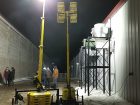
Get the LED out – why LED lighting is taking the rental industry by storm
By Brian Astl president of Lind Equipment
Features Tech tips technologyYou’ve seen the ads. Your electrical utility has probably tried to incent you to buy it for your house. And your new car is full of it. But does LED lighting have a place in your rental lighting equipment?
LED technology has certainly come a long way. Even as recently as 2017, there was not a cost-effective way to replace large metal halide tower lights with an equivalent LED option. But just because it’s possible to have LED in all your rental lighting, does that mean it’s something that you should do? Is there a return on investment for equipment rental in moving to LED? And if so, where does the ROI come from?
We’ll talk about how to find the ROI. And, if the ROI is there, how do you fight through all the specs on lumens, lux, colour temperature and more to select the right LED lighting?
Finding LED ROI for equipment rental
ROI can come from non-intuitive places. For example, replacing your household lights with LED lights does not make sense on the power savings alone. You just don’t run your household lights for long enough to pay back the difference in price via power savings. The ROI in switching to LED is when you hit the number of hours where your old CFL bulb would burn out but the LED is still working. It’s avoiding having to replace the CFL bulb that gives you the ROI from investing in LED for your house. There is a similar argument for equipment rental.
Since you (the equipment rental company) is not actually operating the lights, there is no value to you in the energy saving ability of LED lights. Sure, LED can use 80 per cent less power than traditional bulbs and put out the same light, but the customer is not plugging into your power. So where are the savings for you?
With well-built LED lights, a tremendous amount of maintenance disappears. Maintenance work that you can’t charge for and just results in expenses.
If you currently have bulb-based lighting to rent, whether it be floodlights or tower lights, take a look at how much time is spent internally on changing bulbs and ballasts. Bulbs have intrinsically weak points in the filaments and the glass covers. They break from being transported, being used and eventually just from old age. The same goes for the ballast, a critical part of large-output bulbs, which can be damaged in myriad ways and need replacing. A well-built LED light can come off rent, be given a hose-down if it’s dirty then put right back into service.
Additionally, LED lights can be more cost-effective than bulb-based lights. Take the traditional four-1,000-watt-bulb metal halide generator light tower, for example. Since the lighting technology is so inefficient, the tower needs to have a large generator permanently attached to it. This generator is so significant that most of the cost and weight in the light tower can be directly attributed to it. An LED tower can use 80 per cent less energy and not require a large generator, making it a less expensive asset to buy. Paying less but renting at the same amount is a direct ROI contributor.
Benefits for customers
There is also value for customers to renting LED lighting. LED tower lights, floodlights and cart lights provide your customers with features they will appreciate, which will secure your competitive advantage over their other options.
As mentioned before, LED rental lighting will make bulb changing a thing of the past, which means your customer is always receiving the light they need. LEDs are also significantly more energy-efficient than bulb-based lighting, which means the operating costs for your customers are significantly reduced (especially if they work off generators). LEDs also give off very little heat and start up instantly, creating a safer work environment.
In addition, if built right, LEDs can also create a more flexible work environment. The low energy usage means most LED rental lighting can be either plugged into external power or run off a small suitcase generator. Well-built LED lights are designed with consideration for how the customer uses them, providing for ease of use and easy movement around the job site. Taking advantage of LED technology is simply not enough; there must be innovation in how the LED lighting is deployed to give real value to the end customer.
Selecting the right LED lighting
Since there is the potential for reduced maintenance and asset cost while providing a better solution to your customers, it seems that LED rental lighting might be a no-brainer. However, like any product, there are good LED lights and bad LED lights and everything in between. Knowing how to evaluate a potential LED product is the best way to ensure that you and your customers are happy.
Let’s dive into some of the terminology used, and how you should think about it.
Lumens
Lumens is a measure of the entire light put out by a source of light. This is an objective way of saying how bright the light is. There is no way you should buy an LED light that isn’t as bright as the bulb-based lighting that your customers are used to. It’s just a potentially more expensive way to give your customers less.
That being said, it’s not always easy to match apples to apples when talking about bulb-based lumens and LED lumens. One of the questions that we get on a regular basis is why LED light data sheets show a smaller lumen number than the bulb-based lights they are replacing. If they are truly the same brightness, then shouldn’t the lumen value be the same between the LED light and the traditional bulb?
Take for example our LE980LED large-area LED light, which replaces a 1,000-watt metal halide bulb. The LE980LED produces 30,000 lumens versus the 100,000 lumens reported for a metal halide bulb. How can we claim that they are the same brightness?
It all comes down to the differences in the lighting technology behind LEDs and bulb-based lights. While bulb-based lights may show a higher lumen number, what really matters is how much of that light is actually useable. A 1,000-watt metal halide bulb typically comes in at 100,000 lumens. But that’s the total amount of light it produces. Half of that light comes out of the bulb going in the wrong direction – back into the light fixture housing and not towards the work area. Light fixture reflectors really do very little to reflect the light back, and so you immediately lose half your 100,000 lumens right away.
Of the 50,000 lumens that are projected towards the job site, 40 per cent of that deteriorates in the very early part of the life of a 1,000-watt metal halide bulb. As the bulb ages, its ability to produce light is reduced, and in metal halide bulbs that’s a very quick reduction.
So now you end up with 60 per cent of 50,000 lumens, or 30,000 useable lumens from a 1,000-watt metal halide light. And that’s the same lumens projected by equivalent LED lights that send all their lighting to the job site and have very little light-power deterioration over time.
Ask your potential LED lighting supplier to get to the heart of the issue. Your customers need a certain level of light to do their job and don’t want to be disappointed post-rental.
Colour temperature
You may be surprised to learn that a white light may actually be blue-white, or yellow-white. Sometimes called “cool white” or “warm white,” this range of white is called the colour temperature and is measured in Kelvin. LEDs can be made anywhere along the spectrum, from a warm white 2,700 K to a cool white 5,000 K or more.
The best LEDs are those that match the light temperature that our eyes have evolved to use best: that of sunlight (around 4,500 K). LED lights that are lower Kelvin will look more yellow, which makes it hard for the eyes to discern detail. LED lights that are higher Kelvin will look more blue or purple, which is simply strange to work in and foreign to our eyes.
However, it is cheaper to make high Kelvin (over 5,000 K) LED lights, so you can get an indication right away of the quality of the light by the colour temperature.
Durability
To truly get ROI from your rental equipment, you need to ensure it can be used again and again without needing maintenance or repair. Again, you will not be surprised to learn that there are varying degrees of durability associated with LED lighting.
LED retrofit bulbs (those that can twist into existing bulb-based sockets) are the least durable and are typically made only for indoor use where they will not be subject to physical shocks. While these are cheap to make, customers often find themselves replacing these LED bulbs, which is counter to the value that LED was supposed to add in the first place.
Selecting a purpose-built LED light with a strong outer housing and a truly weatherproof construction is the optimal solution for equipment rental. Look for the ability to be used in “wet” areas, not “damp” areas, as you never know where your equipment will be placed on a job site.
In summary, there are plenty of reasons to move to LED rental lighting for your business, from lower maintenance to a better customer experience. However, be sure to do your homework when buying. We’ve spoken to many equipment rental companies who were soured on LED technology because they bought a light that wasn’t bright enough, or didn’t last very long in the field. Get references, carefully read the specs and ask questions, just like you would when buying any other rental asset.
About the author
Brian Astl is president of Lind Equipment, a manufacturer of portable electrical equipment for the toughest workplaces. Brian holds an MBA from Harvard (with honours) and is a recipient of the 2018 Canada’s Clean50 award, which offers recognition to Canada’s leaders in clean capitalism.
Print this page


Leave a Reply